If you’re a proud pet parent like me, you’re all too familiar with the constant vigilance required to keep our furry friends happy, healthy, and free from harm. One of our common adversaries in this quest? The tiny but troublesome tick. It doesn’t take more than a leisurely stroll through the park, a romp in the backyard, or even just an innocent cuddle on the couch for your canine companion to become an unwitting host to these pesky parasites. Imagine this – you’re giving your pooch their regular belly rub, when your fingers encounter an unexpected bump. Upon closer inspection, it’s a dried dead tick clinging stubbornly to your dog’s skin. This scenario, while undoubtedly distressing, is not uncommon, and it’s essential to know how to handle it safely and effectively.
This blog post is your go-to guide for everything you need to know about ticks on dogs – from understanding these troublesome critters and identifying them on your dog, to dealing with the dreaded dried, dead tick. We’ll walk you through the potential risks these insects pose, how to remove them properly, and what immediate actions to take to ensure your dog’s well-being. We’ll also delve into preventive measures and when it’s time to seek professional help.
So, whether you’re a new dog owner or a seasoned pro, stick around. Let’s arm ourselves with knowledge and keep our four-legged family members tick-free, healthy, and happy!

Understanding Ticks
Alright, let’s dive in, shall we? We’ve all heard of ticks, but what exactly are they? Ticks, my dear readers, are not just tiny nuisances. They are parasitic arachnids – yes, they are distant cousins to spiders – that feed on the blood of mammals, including our canine companions.
Ticks are found all over the world but are particularly prevalent in areas with warm, humid climates. They’re commonly found in tall grass, wooded areas, and even in our own backyards, lying in wait for a potential host. These opportunistic parasites latch onto passing animals (or humans) and make their way to areas of soft skin, where they embed themselves to feast on their host’s blood.
Here’s where it gets a bit unnerving. Ticks aren’t just freeloading bloodsuckers; they’re potential disease vectors, too. As they feed, they can transmit harmful pathogens into their host’s bloodstream. Lyme disease, ehrlichiosis, and anaplasmosis are just a few of the tick-borne illnesses that can affect dogs, causing a range of symptoms from fever and loss of appetite to more severe complications like kidney damage.
Now, it’s not all doom and gloom. The good news is that not all ticks carry diseases, and even those that do often require a specific amount of feeding time (typically 24-48 hours) to transmit these pathogens. This means prompt detection and removal of ticks can significantly reduce the risk of your dog contracting a tick-borne disease.
So there you have it. A crash course in Ticks 101. They might be small, but they’re not to be underestimated. Armed with this knowledge, we can better protect our four-legged friends from these pesky parasites. Stay tuned as we delve into how to spot a tick on your beloved pooch next.
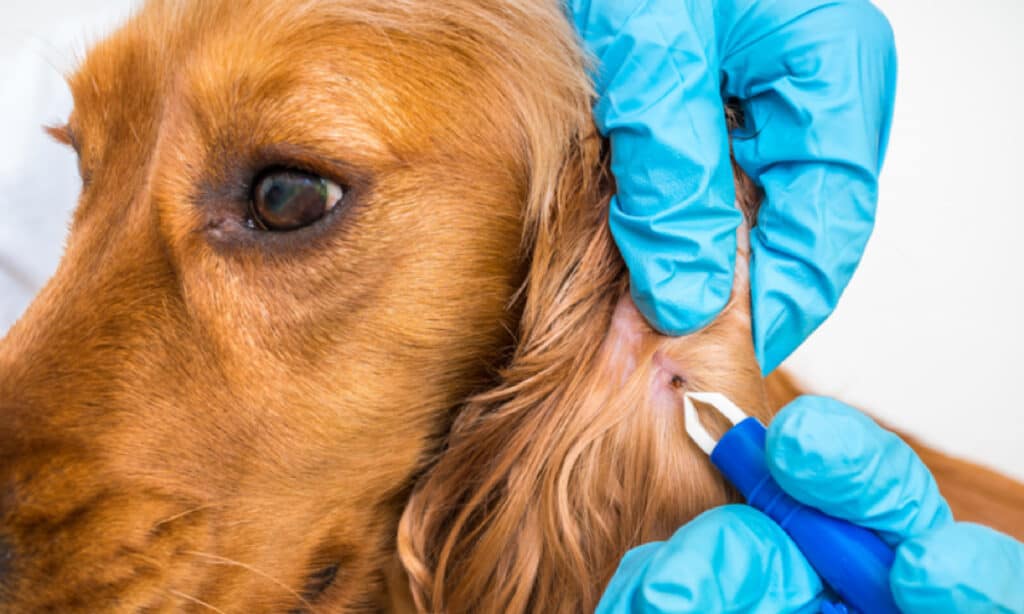
Identifying a Tick on Your Dog
Now that we know more about ticks let’s move on to how you can identify them on your furry friend. Spotting a tick on your dog isn’t always as straightforward as it might seem. These tiny hitchhikers are experts at playing hide-and-seek, often latching onto less visible areas on your dog’s body.
Ticks come in different sizes and colors, but most are small, round, and flat before they have a blood meal. As they feed, they swell and can become the size of a small pea, turning a greyish-blue or brown color. Unlike a small skin lump or growth, a tick will have tiny legs, which are sometimes the giveaway.
Ticks love to hide in warm, protected areas. Common spots to check are around the dog’s ears, neck, between their toes, under their armpits, and around the tail area. Regularly running your hands over your dog’s body can help detect any unusual bumps or lumps that might be a tick.
Remember, ticks can range from the size of a pinhead to a grape, depending on their species and how long they’ve been feeding. A tick that’s been attached for several days and is engorged will look like a small, hard, round lump and may easily be mistaken for a skin growth or cyst. It’s always better to check any suspicious lumps and bumps rather than assuming they’re harmless.
Now, what about identifying a dead tick? Dead ticks that are still attached to your dog will be immobile but will still resemble a small lump. They may be lighter in color or appear grey or brown. They won’t have the shiny, plump appearance of a live, engorged tick and won’t move when touched.
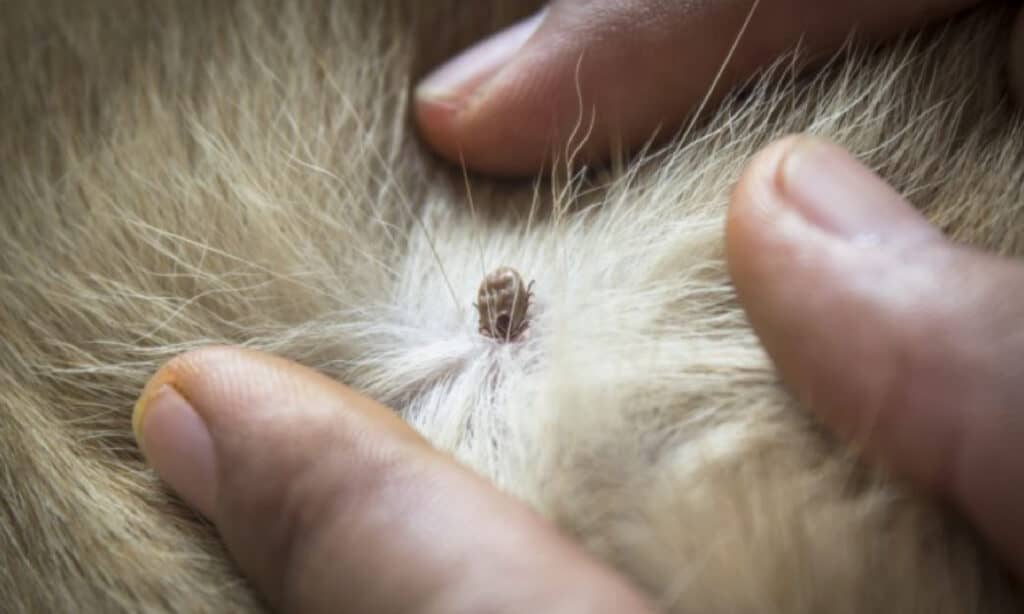
The Risks of a Dead Tick on Your Dog
Alright, moving forward, let’s delve into the risks of leaving a dried, dead tick on your dog. You might think, “Well, it’s dead. What harm can it do now?” However, even in death, a tick can cause trouble.
Firstly, even though the tick may be dead, its mouthparts could still be embedded in your dog’s skin. This can cause irritation and may lead to an infection if not properly treated. The site of the tick bite may become red, swollen, and painful for your pup, and you might notice them scratching or biting at the area more frequently.
Secondly, the dead tick could act as a beacon for other ticks. Certain species of ticks can detect the scent of a dead or dying tick and may be attracted to the area, increasing the risk of further infestations. This is especially true if the dead tick was a female that had laid eggs.
Moreover, it’s important to remember that the tick may have transmitted disease-causing organisms to your dog while it was alive and feeding. Tick-borne diseases such as Lyme disease, ehrlichiosis, and anaplasmosis can cause serious health problems in dogs, and symptoms may not appear for weeks or even months after the tick bite.
In a nutshell, finding a dead tick on your dog isn’t a sign to breathe a sigh of relief. It’s a call to action. In our next section, we’ll guide you on how to properly and safely remove a dead tick from your dog. Remember, it’s not just about getting the tick off; it’s about doing it right to minimize risks to your beloved pet. So, stay with us!
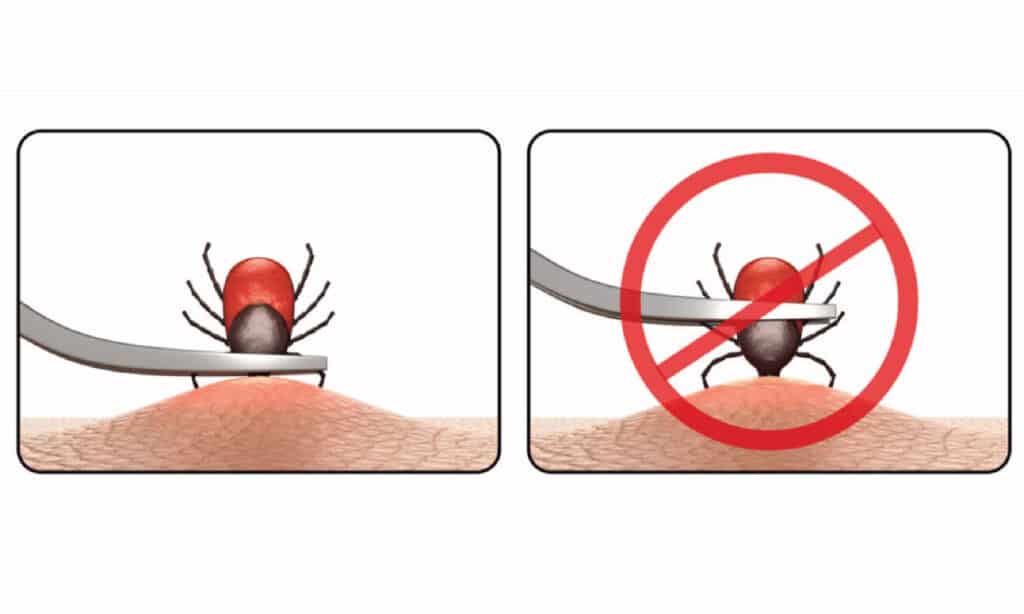
Steps to Safely Remove a Dead Tick from Your Dog
Now that we’ve discussed the risks, it’s time to roll up our sleeves and get into the nitty-gritty of removing that pesky dead tick from your pup.
- Step 1: Gather Your Supplies – You’ll need a pair of fine-tipped tweezers or a specially designed tick removal tool. It’s also a good idea to have some gloves on hand to avoid any potential disease transmission. Also, have rubbing alcohol, a sealable plastic bag or container, and some antibiotic ointment handy.
- Step 2: Protect Yourself – Before you begin, put on your gloves. Remember, ticks can transmit diseases to humans as well.
- Step 3: Removing the Tick – Gently grasp the tick as close to your dog’s skin as possible using your tweezers. Try not to squeeze the tick’s body, as this could potentially release harmful bacteria. Once you have a firm grip, pull upward with steady, even pressure. The goal is to remove the entire tick, including its mouthparts, which can cause infection if left behind.
- Step 4: Clean the Area – After successfully removing the tick, clean the bite area and your tweezers with rubbing alcohol. Then apply a dab of antibiotic ointment to the bite area to prevent infection.
- Step 5: Dispose of the Tick – Place the tick in the sealable bag or container. Alternatively, you can flush it down the toilet.
- Step 6: Monitor Your Dog – Keep an eye on the bite site for the next few weeks. If you notice any redness, swelling, or if your dog seems unwell (lethargic, loss of appetite, fever), contact your vet immediately.
Just remember to be calm, collected, and gentle. In our next section, we’ll cover what you should do after the tick has been removed, so stick around!

Immediate Aftercare
Perfect, let’s move on to the all-important stage of immediate aftercare. Just as we humans need a little TLC after a trip to the doctor, our dogs need some extra care after a tick removal.
- Cleaning the Bite Site: Once the tick has been safely removed, you should clean the bite site again with some warm water and mild soap, followed by another round of disinfecting with rubbing alcohol or a pet-friendly antiseptic. This helps to eliminate any leftover bacteria that could cause an infection.
- Apply an Antibiotic Ointment: To prevent infection, apply an antibiotic ointment to the area. You can use a product like Neosporin. Remember, some products safe for humans may not be safe for our four-legged friends.
- Monitor the Bite Site: Keep an eye on the area where the tick was attached for the next several days. It’s normal for a small scab to form, but watch out for continued redness, swelling, or any discharge. If you notice your dog excessively licking, scratching, or biting at the area, it could be a sign of discomfort and should be checked out by your vet.
- Check Your Dog’s Overall Health: Beyond the bite site, monitor your dog’s overall health. If your dog shows any signs of lethargy, loss of appetite, lameness, fever, or any unusual behavior, it’s crucial to contact your vet right away. These could be signs of a tick-borne disease, which can take several days to weeks to manifest.
- Praise and Reward Your Dog: Last but definitely not least, give your dog plenty of praise and a treat or two for behaving during the tick removal process.
Tick removal isn’t the most pleasant experience, but with the right aftercare, your dog will be back to their happy, healthy self in no time.
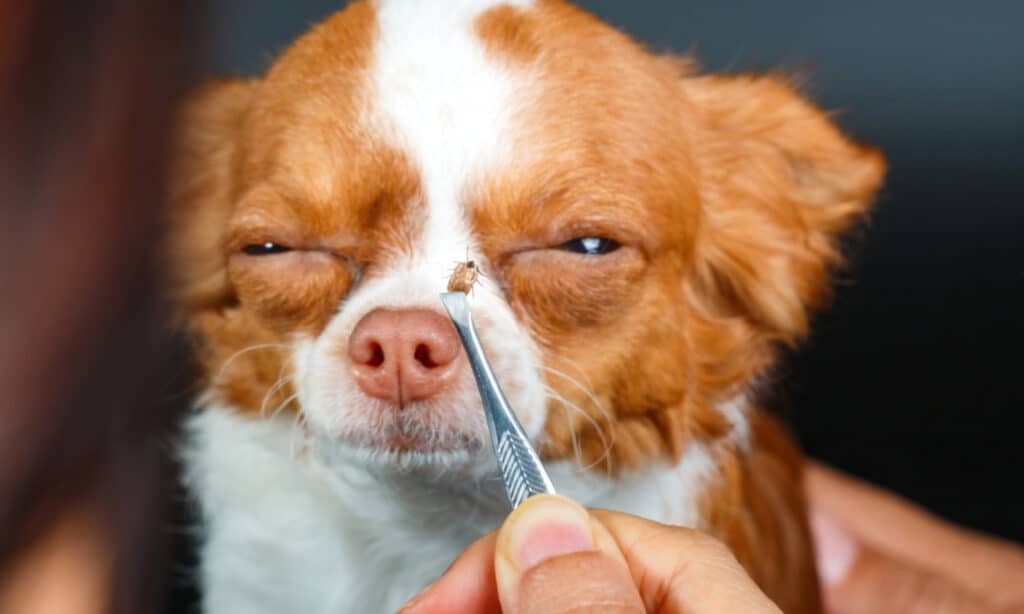
Prevention and Long-term Care
As the old saying goes, “An ounce of prevention is worth a pound of cure,” and when it comes to ticks, this couldn’t be more accurate. Let’s look at some effective strategies for tick prevention and long-term care for our beloved dogs.
- Regular Tick Checks: The first step in prevention is vigilance. Make it a habit to perform regular tick checks on your dog, especially after they’ve been outside in wooded or grassy areas. Remember to check those ‘hot spots’ where ticks love to hide!
- Topical Treatments, Oral Medications, and Tick Collars: There are several over-the-counter and prescription products available that can help repel or kill ticks. Topical treatments are applied to your dog’s skin once a month, while oral medications are given by mouth. Tick collars can provide long-lasting protection. It’s best to consult with your vet to find the most suitable option for your dog.
- Maintain Your Yard: Ticks love tall grass, brush, and leaf litter. Regularly mowing your lawn, removing leaves, and trimming back shrubs can create a less inviting environment for ticks.
- Vaccinate: While there is no vaccine for all tick-borne diseases, there is one for Lyme disease, which is one of the most common diseases carried by ticks. Discuss with your vet whether this might be a good option for your dog, especially if you live in a Lyme-prevalent area.
- Regular Vet Check-ups: Regular vet check-ups are crucial for early detection and treatment of any potential tick-borne diseases. Make sure to keep up with your dog’s regular wellness visits.
Remember, no preventative measure is 100% effective, so a combination of methods is often the best approach. A tick-free dog is a happy and healthy dog, so investing time in prevention and long-term care will pay off in the long run.
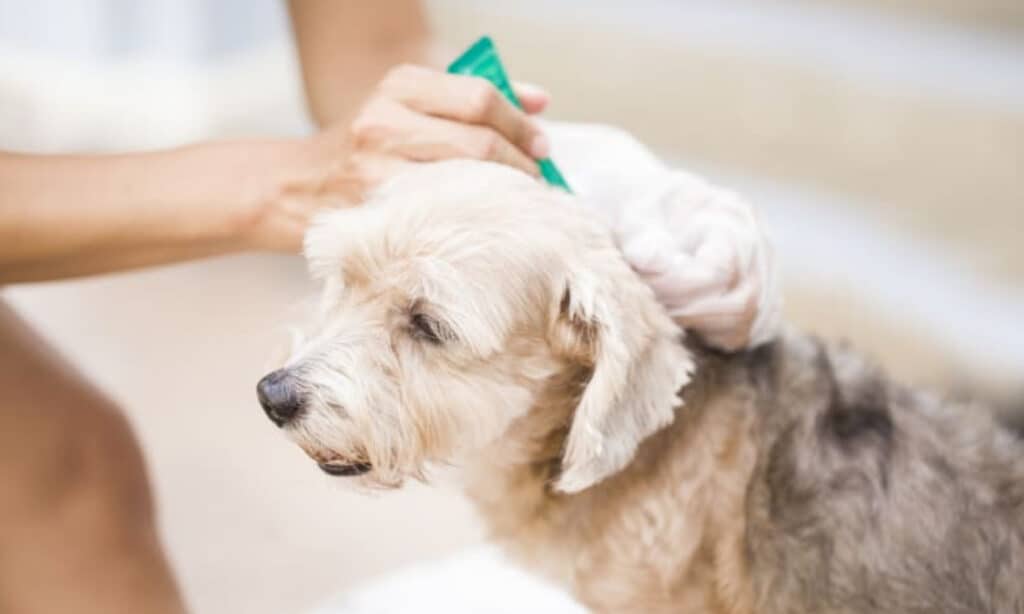
The Dangers Of Tick-Borne Disease
Let’s dive into the potential dangers of tick-borne diseases in dogs, their signs and symptoms, and the treatment options available.
- Lyme Disease: Perhaps the most well-known tick-borne disease, Lyme disease is caused by the bacterium Borrelia burgdorferi. Symptoms can take two to five months to appear and may include lameness, joint swelling, fever, fatigue, and loss of appetite. If left untreated, Lyme disease can cause damage to the kidneys and other organs. Treatment typically involves a course of antibiotics and supportive care.
- Ehrlichiosis: Ehrlichiosis is another serious disease transmitted by ticks. It affects the white blood cells and can cause symptoms like fever, loss of appetite, weight loss, nose bleeds, and swelling of the legs or joints. Treatment typically involves antibiotics, and in severe cases, blood transfusions may be necessary.
- Anaplasmosis: Also known as dog tick fever, anaplasmosis presents symptoms similar to Lyme disease, including lameness, joint pain, fever, and lethargy. It can also cause vomiting, diarrhea, and possibly seizures if it infects the nervous system. Treatment is usually a course of antibiotics.
- Rocky Mountain Spotted Fever: Despite its name, this disease is found throughout North and South America. Symptoms include fever, joint pain, coughing, abdominal pain, vomiting, and diarrhea. In severe cases, it can cause serious damage to the kidneys and heart. Treatment typically involves antibiotics and supportive care.
Remember, the symptoms of tick-borne diseases can take weeks or even months to appear and may come and go, making them hard to spot. Regular vet check-ups and blood tests can help with early detection and treatment. It’s also crucial to let your vet know immediately if you’ve found a tick on your dog, even if it’s dead, as this information can help your vet decide whether to test for tick-borne diseases.
When to Seek Veterinary Help
We can’t stress enough how important it is to know when to seek veterinary help when dealing with ticks and potential tick-borne diseases. While it’s something we all hope to avoid, being prepared can make all the difference.
- Difficulty Removing the Tick: If you’re having trouble removing a tick, or if the tick’s mouthparts remain embedded after removal, it’s best to seek professional help. Your vet can remove the tick safely and ensure the bite area is properly cleaned and treated to avoid infection.
- Signs of Infection at the Bite Site: If the area where the tick was attached becomes red, swollen, warm, or painful, or if there’s a discharge, these are signs of potential infection and you should contact your vet immediately.
- Your Dog Becomes Unwell: If your dog starts to show any signs of illness, such as lethargy, loss of appetite, fever, limping, or any unusual behavior, contact your vet straight away. These could be signs of a tick-borne disease, which can take several days to weeks to appear after a tick bite.
- Presence of Multiple Ticks: If you find multiple ticks on your dog, it’s a good idea to consult your vet. They can help ensure all ticks are properly removed and discuss more effective tick prevention strategies with you.
- If Your Dog is Not On a Preventative Treatment: If you find a tick on your dog and they aren’t currently on a tick preventative treatment, contact your vet. They can recommend an appropriate product to help prevent future infestations.
Ticks can be pesky and potentially dangerous critters, but with the right knowledge and resources, we can protect our dogs and keep them happy and healthy.
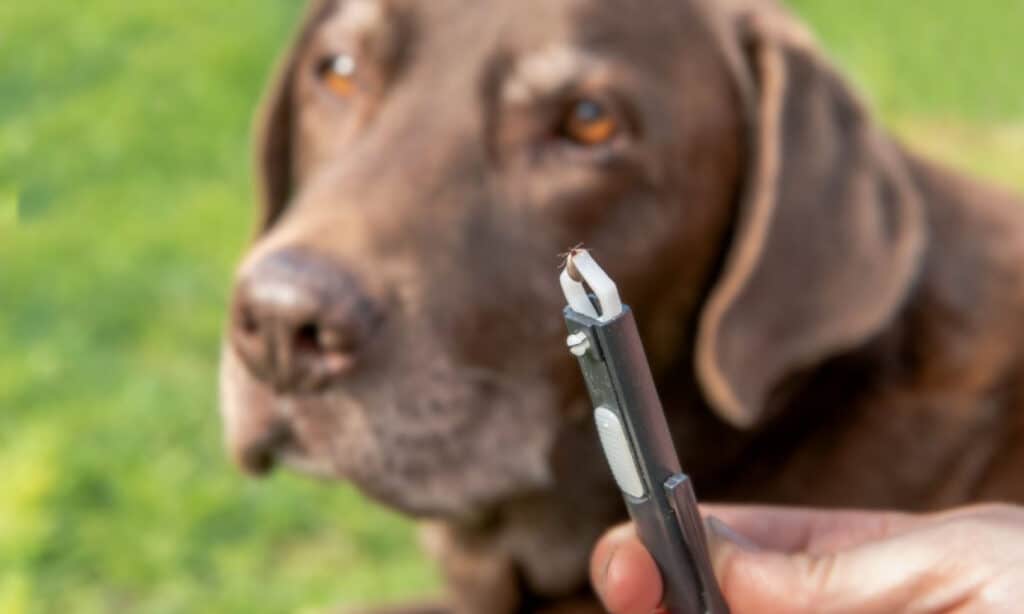
Conclusion
Ticks may be small, but they can pose a significant threat to our beloved dogs. From understanding what ticks are and how to identify them on your pet, to knowing the risks of a dead tick, we’ve covered a lot of ground in this guide. We’ve learned the correct steps to safely remove a tick and the necessary aftercare to ensure our dogs bounce back quickly. Importantly, we’ve explored the critical preventative measures and long-term care strategies to protect our pets from future tick encounters.
Understanding the signs, symptoms, and treatments of various tick-borne diseases is an essential part of being a responsible pet owner. And knowing when to seek veterinary help can make all the difference in keeping our furry friends healthy and happy.
Despite the challenges ticks may present, remember that you’re not alone in this. Veterinarians, pet experts, and fellow pet owners are all part of your support network. Being proactive, staying informed, and consulting with professionals when needed can effectively safeguard your dog from the risks ticks pose.
Let’s take our knowledge forward, practicing vigilance and prevention to ensure our dogs live their best, tick-free lives. After all, our dogs depend on us just as much as we cherish their companionship, and they deserve nothing but the best care we can provide.
Thank you for joining us on this journey through tick prevention and care. Keep this guide handy, share it with fellow dog owners, and let’s continue to prioritize the health and well-being of our four-legged family members. Until next time, stay tick-free and enjoy the boundless joys of dog ownership.
~Lindsie
